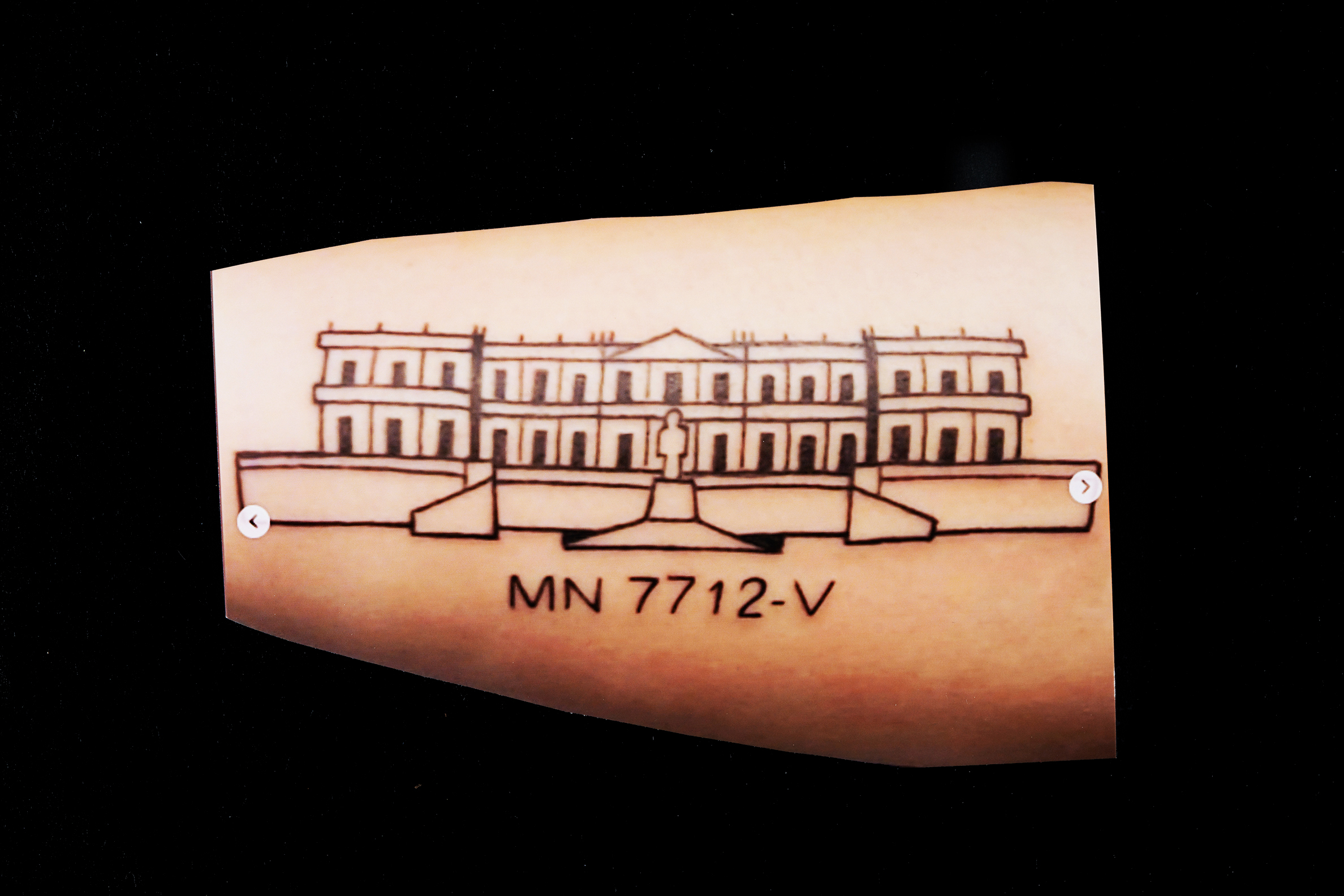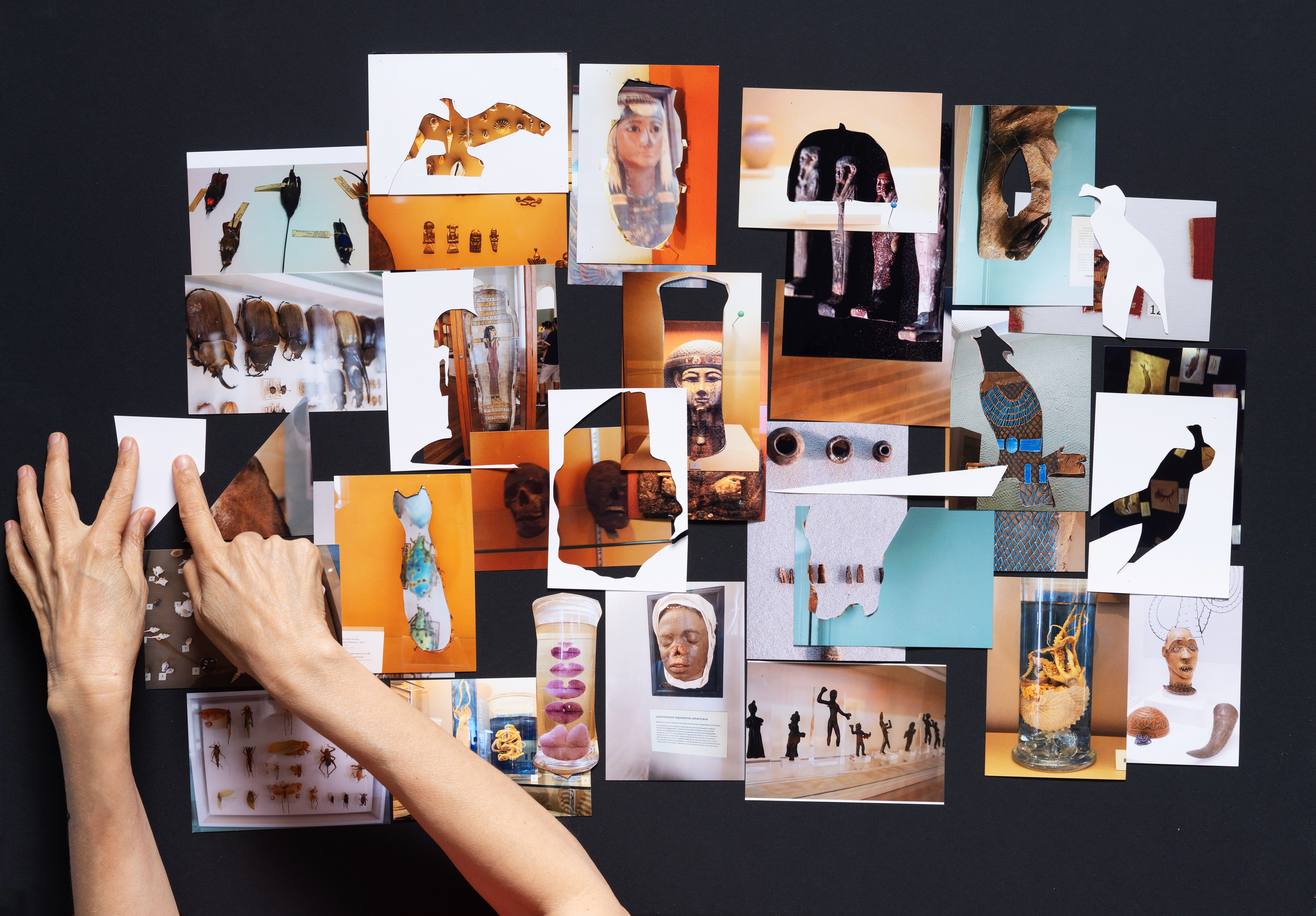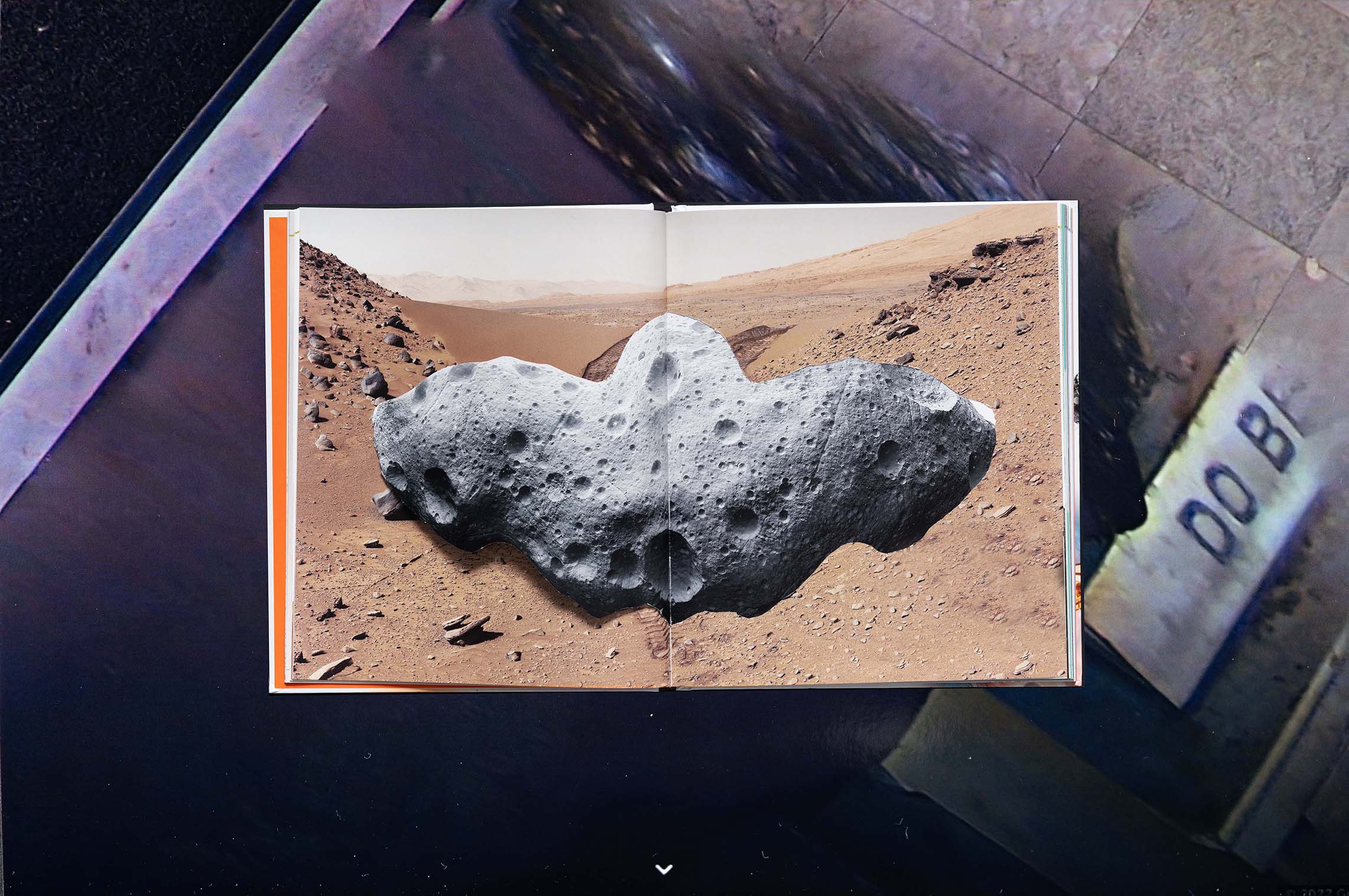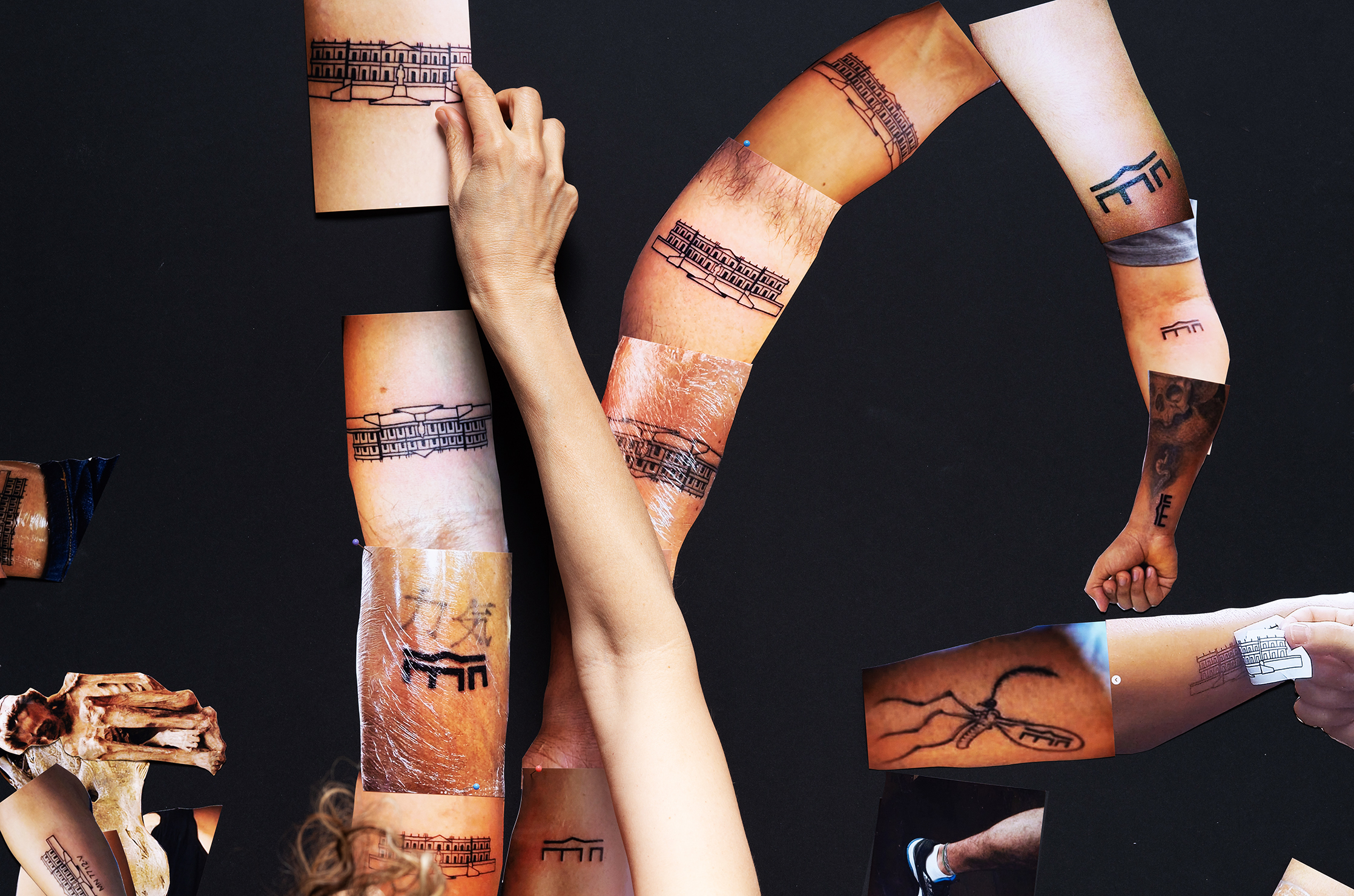









Testimonies of Things
Testimonies of Things is a series of experimental writing and photographic works motivated by the notion of non-human testimonies about the museum fire. The speculative series aims to splice scientific and poetic knowledges of in order to capture the transition from matter or bio form to the digital realm through the perspective of six entities.
1. Meteorite
Pedra do Bendegó travelled from space to the Brazilian region of Bahia, where it rested still on the ground for several thousand years. An irregular mass, 5,360 kilograms of iron covered by a ten-centimeter layer of oxidation, it has numerous depressions on its surface and cy- lindrical holes parallel to its greater length. Part of its lower portion was lost during landing and left a smooth surface on one face. Besides iron, the meteorite also consists nickel, cobalt, phosphorus, and traces of sulfur and carbon in much smaller quantities.
Ever since it first came into contact with human eyes, the iron has been on the move again. A boy called Domingos da Motta Botelho was grazing cattle on a farm near what is now the town of Monte Santo when he first spotted the meteorite in 1784. Even considering the slow local movement of people and commerce, the news of the finding spread quickly. In 1785, the region’s governor, D. Rodrigues Menezes, arranged for the meteorite to be transported to the city of Salva- dor, however, its weight made transportation difficult. The cart it was placed on lost control and the meteorite fell into a dry stream bed, 180 meters away from the spot where it was initially found. The meteorite didn’t travel with the people, but the people started to visit Bendegó. The London scien- tific academy the Royal Society published A. F. Mornay’s drawings of the meteorite in its periodical, Philosophical Transactions of the Royal Society, and the first reproduction of the metal rock started to orbit the visual sphere. Seventy years later, the meteorite was lifted and rolled to the National Mu- seum of Brazil and stopped right by the door.
In the first room of the museum, past the armed personnel and the metal turnstiles, it rested on a pedestal for 130 years. Always the first thing in sight, the first image taken. Then the fire happened. No major damage. Standing still. Long lasting after the museum. The first room, behind the metal turnstiles, all covered with ashes from burnt neighboring objects. Images were uploaded and downloaded, links were shared, posts were posted. Pictures transmitted up toward space and back down to the Brazilian earth. What are the means with which the earth sees? After the ashes and images rested, I clicked on the link and entered the museum again. I passed the two blurry-faced armed personnel and glided through the metal turnstiles. On my way to the staircase, I dragged my cursor around and above Bendengó, smearing glitches with depressions and cylinder-shaped holes, forming a geo-digital irregular mass of image-matter.
2. Water
The line for the paddleboats was long. There were birthday tables decorated in matching colors and helium balloons. Young girls were posing in front of their cameras and tagging the Quinta. It was September, and spring was finally here. Quinta da Boa Vista was a farm surround- ed by mangroves and swamps, but Elias António Lopes, who built a manor house on top of its hill, had to donate it to the Portuguese Prince. The gift was much appreciated. Up the hill, the manor became a palace, that then turned into a museum of mankind. Down the hill, swamps turned into roads, and lands were curved into lakes to decorate the view from the palace. Animals were brought in from many parts of the world to roam around it. Peacocks, toucans, and swans. Two man-made containers of wonders and pleasures, open to some bodies. Then the fire happened. Uphill, worlds were burning fast, wing by wing. The first responders fighting the fire were hindered by insufficient water. The two fire hydrants next to the museum had no supply. An error. Everything slowed down. Never-ending minutes in the head of Colonel Roberto Robaday, who had to act fast. How do you extinguish a fire without water? It took two more hours until the firefighters started to pump water from the swamp. The Pedalinhos lake, where peacocks were piercing, and toucans were singing, and the swan-shaped paddleboats were always waiting. Facts and fables were rigged. Hoses and gate valves rolled and clicked, stretching the water between two containers of wonders.
For some time, the pressure in the fire hydrant was low, but the high pressure of real estate and industry developers didn’t stop pumping, bringing the system to the brink of collapse. This is a dry season for fire hydrants, and water pumps, and local reservoirs, and natural watersheds. For some time now, bodies of water have slowly been dehydrating under official priorities. For modern water, dry became a condition. The museum was an old building. An old building with all sorts of old lives, old debts, and no liquid assets. The government support dried out long ago. The city was busy building a brand new “museum of tomorrow.” It was a question of liquidity. Fire was the method.
3. Ashes
Through Rio de Janeiro’s night sky, ashes flew up to the air and fell on the ground. Burnt anthropoids and ancient cockroaches dropped in backyards. Employee surveys and rejected paperwork fell quietly on stoops and balconies, like foliage. Index cards landed on the neighbor’s front porch. Burnt particles from other lives took local flights, and touched down much closer to home. Ashes scattered and spread out the word, like silent witnesses carried by the whispering wind.
Pedro Luiz loves ashes and sarcophagi. Ashes are the best storytellers and sarcoph- agi are the best mystery. An expert on Egyptian monuments, he was brushing dust for a living. If you can call it a living. His work at the National Museum was like living in a giant, Russian doll–shaped sarcophagus. A memory chamber of all sorts of things that were once alive and are now kept in jars and glass cases, registrar forms and long lists, catalogues and exhibition shots, and photocopies. Many photocopies. Also, slides and films, tapes and floppy disks, and CD-ROMs and memory sticks that sometimes reminded him of specters. Moving between rooms and boxes, he imagined his work- place is a giant beast fed with dead life-forms and memory forms, each has a copy. But for Pedro, death is where life is, so life was good.
For a while now, Pedro has been using his tools to excavate his own workplace. Cof- fins and amulets, staples and line levels, and spectral memory sticks. New ashes consumed old ash- es, new death consumed old death. The matter that recorded the evidence of violence is devoured by its own materiality. Necro-metabolism. Pedro brushes, measures, and puts things in boxes. He thinks of the Sanöma people, who live in the Yanomami land, who destroy the marks of the dead by consuming their corporality. The meticulous practice of remembering in order to forget include drinking the liquids that came out of the deceased, pulverizing their bones, consuming the ashes, and eating the rest, mixed with banana porridge. The dead have a right to be forgotten. Their own deeds—forget them; their own lives—erase them; their belongings must be burned. The metabolic system is a hell of a mnemonic device. Pedro sticks boxes in rooms. A colleague tells him, “The origi- nal pieces that were there are part of our conquest through the struggles of our loved ones who are not here. Now we have memories, more than we live because they are live for us.” And Pedro thinks of living with them, with us, dead or alive. Ashes, ashes, we all fall down.
4. Skins
Tropical climate is good for composting, not so much for mummies. But for 600 years a twenty-five-year-old woman was buried in a cave in Minas Gerais until Maria José de Santana, the owner of a coffee farm, discovered her in perfect condition. Her skin still stretched like a gift wrap over her body. It was the nineteenth century, so Maria gave her ancient young sister to Dom Pedro II, who added the gift to his collection. It wouldn’t be the first skin that was given to Dom Pedro. Nor the first body. A Chilean man, who was buried seated was still sitting in a glass box. His knees are drawn under his chin, like a shy boy. His skin covers his body like a dry container.
Then the fire happened, leaving scars all over. Inside the hazy galleries, a new skin starts growing. Skins were leaving their toxic bodies, growing like a free creature inside the great halls, smells of killing. The skin of the young woman from Minas Gerais comes off her bones; the Chilean mummy peels a layer from its folded cover; the mummified cat sticks to the snakeskin; burnt skins grow their own living mesh; and people started to ink the museum on their own skins. MN 7712-V. New black ink on the arm of paleontologist Beatriz Hörmanseder marked the serial number of a crocodile fossil they were studying. 06-06. A Quaternary Geographer, Suzanna Matos shared her birthday with the museum. The ritual of marking started small and grew via the social epidermis into a small movement, #museunapele. Entomologist Ivyn Sousa tattooed her lab’s win- dow bars, where toucans regularly landed. Architect Marco Hermann who planned the roof ren- ovation traced the blueprint of the museum façade. He kissed the ink before it dried. Their skins were faster than their words. A social skin was coming together, wearing the museum of mankind. The skin is witnessing. The rage is inked deep.
5. JPEG
A fragmented and eclectic digital collection survived from the ruins. The images, all taken by small interest groups and visitors, are now stored on their personal devices or on cloud services and are shared via social media. The photos became a portal to the very different data they were slowly aggregating: other images they saw, locations they checked in at, a personal library or- ganized by geolocation or facial recognition software, social networks, and other data points. Each file is named by its contributor. One is named «mollusks shells.jpg,» the other «Sofia and Dino11. jpg.» A new princess in what once was a palace, then a museum, and now a library of lossy-compres- sioned digital images. Copies in motion, squeezed into a 1:10 ratio. Ripped many times over. Does a JPEG has a memory? There is also a virtual tour, a product of Google Arts & Culture, where one can visit the no-longer-existing museum. No more boxes and cabinets, the objects are now robbed of the capacity to be present. They are stored through the same interface as your street.
6. Cursor
Screens remained on all night, measuring in real time the ever-growing black cloud above the palace. Talking heads were stuttering broken sentences that were not translated. Cur- sors moved forward and backward, typing words with such lightness, as if writing and deleting were equally painful. Sometimes, all one can do is watch the fire. The internet seemed to be working. DrawIn, the user who just created a Wikipedia page dedicated to the fire, got to the museum before the firemen. With others, he started copying the database, folder by folder, collecting the data from the ruins. By midday the database was suddenly gone. Things that are gone have less of a chance to ruin elections and the elections were only a month away.
In one room, Sala Kumbukumbu, dedicated to Afro-Brazilian cultures, they collected 1000 individual records. Kumbukumbu, a word that means “objects, people, or events that make us think about the past.” My cursor is scrolling down the database, then dragging me around the room. My cursor is a runner, a moving body without flesh, motivated by language. It stops at the room where the people are gone, and the objects are robbed, and the language is broken: Ob jjject spe pleore v entst-hatma ke u ssssth ink aboutttt thepassssst. My cursor is holding things together by keeping my words apart. My cursor interrupts. It tells me when action is needed. A tilted arrow, with an extra pixel on top, pointing toward the things that make us think about the past.